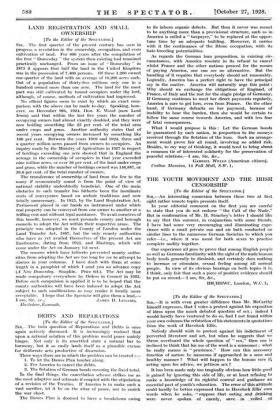LAND REGISTRATION AND SMALL OWNERSHIP [To the Editor of the
SPECTATOR.]
SIE,—The first quarter of the present century has seen in progress a revolution in the ownership, occupation, and even cultivation of land. For 800 years after the compilation of the first " Domesday " the system then existing had remained practically unchanged. From an issue of " Domesday " in 1875 it appears that half the land in the United Kingdom was in the possession of 7,400 persons. Of these 1,200 owned one-quarter of the land with an average of 16,200 acres each. Out of a population of thirty-five millions only one in a hundred owned more than one acre. The land for the most part was still cultivated by tenant occupiers under the lord, although, of course, methods of cultivation had improved.
No official figures seem to exist by which an exact com- parison with the above can be made to-day. Speaking, how- ever, on December 9th, 1924, Hon. E. Wood (now Lord Irwin) said that within the last five years the number of occupying owners had almost exactly doubled, and they were now holding something like 25 per cent. of the total area under crops and grass. Another authority states that of recent years occupying owners increased by something like 100 per cent. Between the years 1919 and 1924, three and a quarter million acres passed from owners to occupiers. An inquiry made by the Ministry of Agriculture in 1927 in respect of holdings exceeding one acre showed that in England the acreage in the ownership of occupiers in that year exceeded nine million acres, or over 36 per cent. of the land under crops and grass, while the number of holdings owned was 146,887, or 36.6 per cent. of the total number of owners.
The transference of ownership of land from the few to the
many if economically sound is from the point of view of national stability undoubtedly beneficial. One of the main, obstacles to such transfer has hitherto been the inordinate costs of conveyance based on archaic traditions and now totally unnecessary. In 1925, by the Land Registration Act, Parliament placed in our hands an instrument under which real property can be conveyed from one owner to another at a trifling cost and without legal assistance. To avail ourselves of this benefit, however, we must persuade county and borough councils to adopt the Act within their respective areas. The principle was adopted in the County of London under the Land Transfer Act, 1897, but the only county authorities who have as yet availed themselves of the present Act are Eastbourne, dating from 1925, and Hastings, which will come under the Act on January 1st next.
The reasons which have hitherto prevented county autho-
rities from adopting the Act are too long for me to attempt to discuss in your columns. I have dealt with them at some length in a pamphlet of which I send you an advance copy (A New Domesday. Shnpkin. Price 6d.). The Act may be made compulsory everywhere by Orders in Council in 1985. Before such compulsion is applied it is to be hoped that the county authorities will have been Induced to adopt the Act subject to such modifications as may render it locally more acceptable. I hope that the Spectator will give them a lead.—




















































 Previous page
Previous page